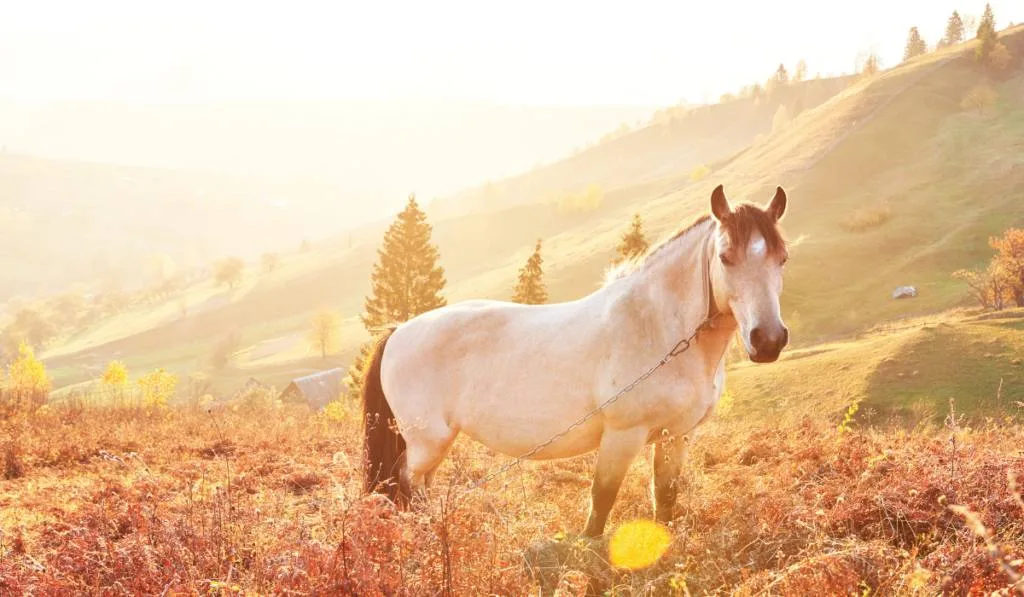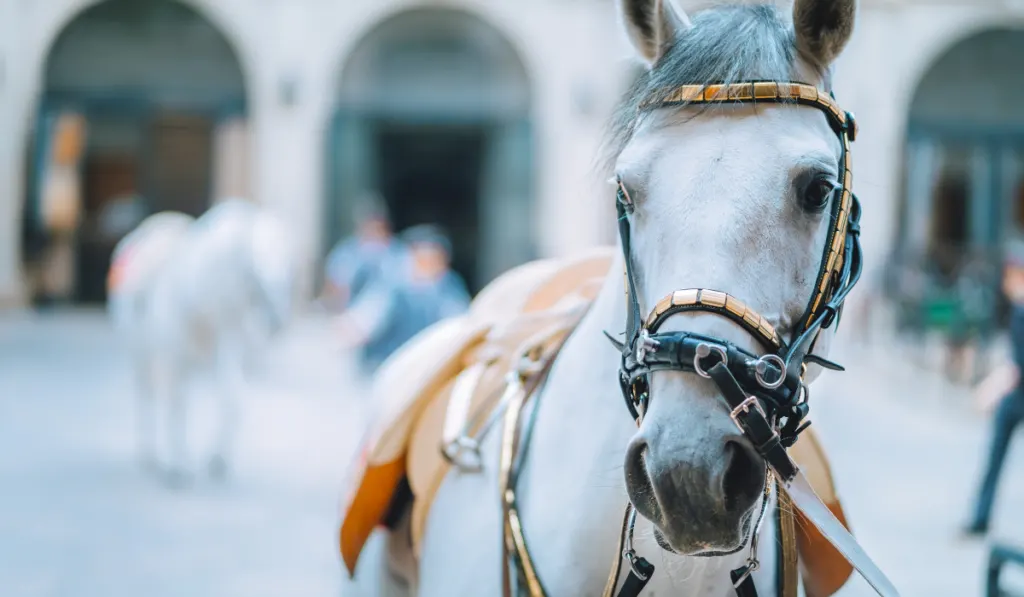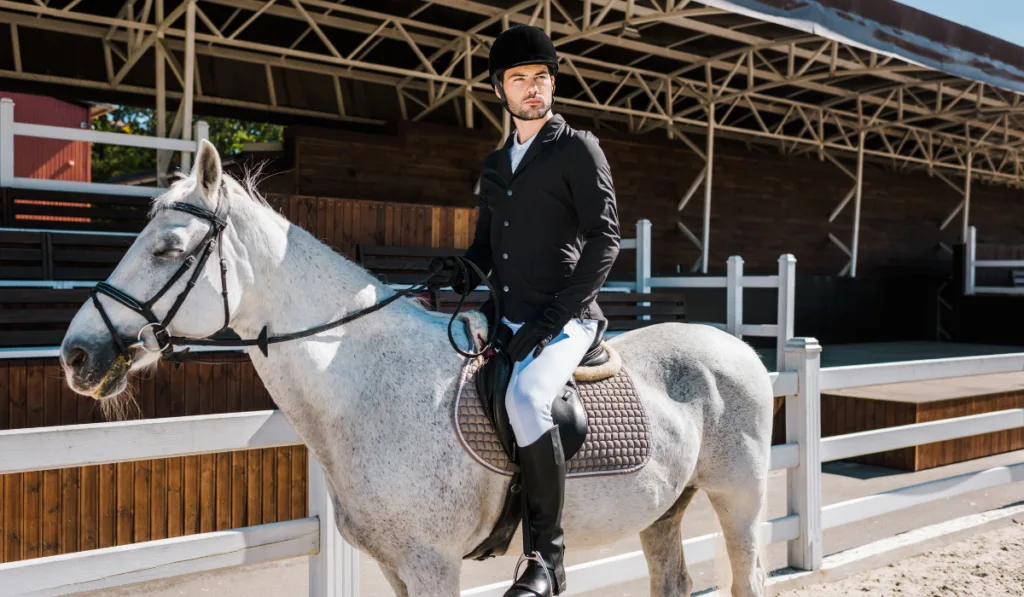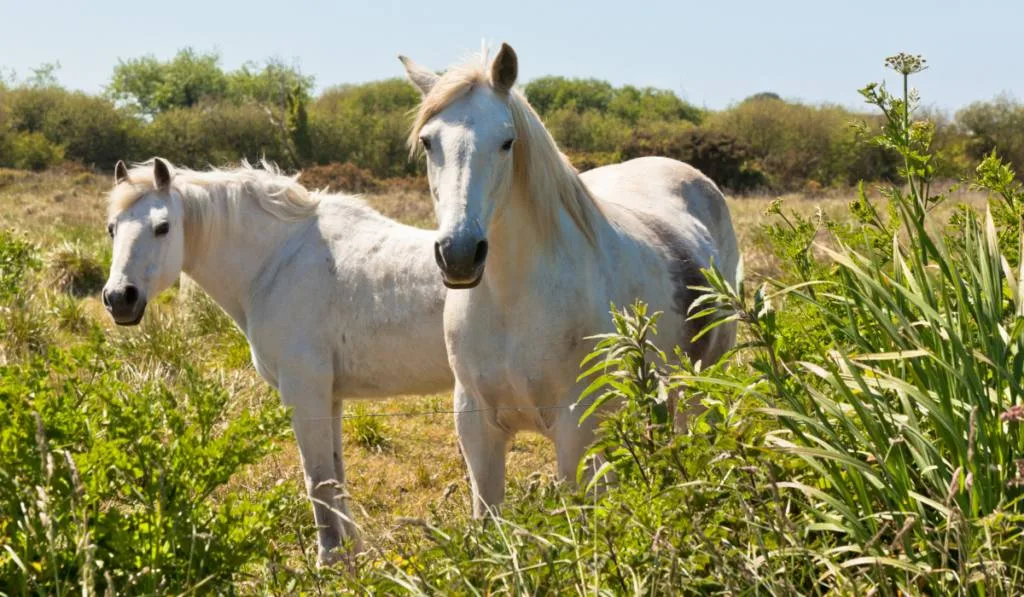Honestly, white horses are strikingly beautiful. No wonder they are quite popular with magical stories such as those of unicorns and princesses. Although white horses are quite common, true white horse breeds are quite rare. How is a true white horse different from a common white horse?
Table of Contents
What is a True White Horse?
Although this might sound simple, the answer is not as simple as a horse with a white coat.
True white horses are those that are born with a white coat that remains white throughout their lives.
True white horses also have flawless, pink skin and dark eyes, and they retain this complexion even as they age. However, some white horses are born with complexions they may lose as they grow older.
Their white hairs and pink skins are a result of a lack of melanocytes, pigmentation cells that may be lacking in the animal’s skin due to its genetic makeup.
That being said, some white horse breeds are a result of careful and selective breeding for a white coat. Therefore, although they may have white coats, they may not be true white breeds.

On the other hand, horses that appear to look white are more common than the rare, true white horses. Some horses are not genetically white but develop the white coat over time as they age.
However, you should know that white has a lot of strains, from gray to cream to pearl.
Gray horses, for example, can be born with a different color, but due to the presence of the gray gene, their coat will gradually turn white as their hair sheds over the years. Some gray horses may end up being entirely white.
However, it doesn’t take much to distinguish a true white horse from one that is not a true white.
From the physical aspects, a horse that is not a true white will have darker skin compared to the usual pink skin for true whites. If you also know that your horse wasn’t born originally white but is gradually turning or has turned white, then it is not a true white horse.
Some other white horse breeds, like cream, also exist as a result of a dilution of genes. When this happens, the horse ends up with diluted and fewer body pigmentation genes, rather than lacking them altogether.
Due to the diluted genes, the horse might appear white, but this is not the horse’s color. It only assumes the cream color but is not genetically white.

19 Breeds With True White Horses
Now that we know how to distinguish true white horses from those that have white coats, let’s have a detailed look at the breeds of true white horses and those that produce white breeds.
1. Arabian Horses
The white strains are common for most Arabian horse strains, such as the Shagya Arabian, but they are not true white horses, as evidenced by the dark skin beneath their hairs.
Arabians are native to the Arabian peninsula, where the sun can be extreme most times of the year, so their dark skin protects them from the sun. If Arabians were true white horses, they would succumb to sunburn due to the pink skin associated with pure white breeds.
However, Arabian horse lines also have non-Arabian genetics. So this is the reason why there is an emergence of white Arabians with pink skins. This might have come into existence because of a parent horse with a dominant white gene that arose from mutations.
Other than white, Arabian horse breeds are also available in the bay, black, gray, and chestnut colors. They stand tall at an average of 15 to 16 hands, and with an excellent and strong bone structure.
Arabian horses are known to have great endurance abilities, making them the best choices for cavalries, carriages, and recreational purposes such as sports.

2. American Paint Horse
Although they are not usually entirely white, American paint horses are considered true white horses because their distinctive color markings form due to the consistency of the white hairs on their pink skins, making them partially true whites.
Therefore, although they may have a blend of color patterns, American Paint horses are regarded as true white breeds instead of a color breed.
3. Missouri Fox Trotter
Native to Missouri, this white horse breed has its name coined from its unique, ambling foxtrot gait. It is also a product of a crossbreed between other potential white horses including the Morgans, Arabians, American Saddlebreds, Standardbreds, and the Tennessee Walking horses.
The Missouri Fox trotter has a well-built reputation for having excellent bones, good stamina, and being sure-footed, making them highly suitable for activities like trail riding, where such qualities are highly in need.
Although Fox Trotters are mostly solid colors, white is very rare and only comes about due to the presence of a dominant sabino-1 gene.
4. Lipizzan (or Lipizzaner)
The Lipizzan’s history dates back to the 16th century Habsburg monarchy in Slovenia. They were selectively bred by the royalty to be gray, as this was their most preferred color. This horse breed also took its name from the prestigious Lipizza Stud farm found in modern-day Slovenia.
Although the Lipizzan foals are generally born black or dark brown, they whiten and develop the dominant gray color or whitish cream as they grow. However, black and bay colors also occur. Lipizzans grow to a height of 14.2 to 16.1 hands.
The Lipizzan is known for its agility and athletic figure. This is the reason why Lipizzans were originally used for sports.
Today, the Lipizzan performs highly complex classical dressage moves such as the “above the air” or “e’cole,” making it a popular choice for horse riders and even carriage driving.
Although they are slow at maturing and growing, Lipizzans have excellent longevity and often live into their 20s. However, they are listed among the rarest horse breeds, with a population of less than 3,000 across the globe.

5. Camarillo White Horse
The Camarillo White horse is a true white horse, evidenced by its white coat and its pink skin. It is also one of the rarest breeds.
About 100 years ago, the first of this breed was born. They were crosses between a Spanish mustang called Sultan, owned by Adolfo Camarillo, and Morgan mares.
This breed is a true white breed because of a certain gene mutation in the sabino-1 gene that doesn’t allow the formation of coat pigments. Therefore, they are exclusively white.
Upon attaining maturity, Camarillo white horses have medium-sized heads, well-arched and strong necks, sturdy bodies, strong legs, and prominent eyes. They stand at an average of 14 to 17 hands high.
However, soon after they first came into existence, the number of this breed greatly declined. By 1991, only 11 Camarillo White horses were left, thereby necessitating the development of a studbook so that new bloodlines could be introduced into the breed for selective breeding.
As a result, the numbers have gradually risen to about 30 horses. Although the breed has survived the test of time, most people will never get the chance to see them in the flesh.
6. The Thoroughbred
The origin of the Thoroughbred can be traced back to 17th-century England when the horse racing industry started booming. The Thoroughbred was introduced to the U.S. in 1730, where it fast gained popularity for its agile racing abilities.
A Thoroughbred is a crossbreed of three-parent stallions, namely the Godolphin Arabian, the Darley Arabian, and the Byerly Turk.
Thoroughbreds have their coats in solid colors, mainly ranging from gray, whitish cream, bay, brown, black, and chestnut. For Thoroughbreds, true white is rare, but when it occurs, it is caused by a dominant white gene that causes pink skin and the growth of white hairs.
They also grow to an average height of 15 to 17 hands when fully mature, and they develop a long neck, sturdy figure, and powerful hindquarters, all of which contribute to their agility, speed, and athletic ability. Thus, Thoroughbreds have a good reputation in horse racing, dressage, show rings, and other equine sports.

7. American Quarter Horse
This horse’s name was given for the horse’s prowess in quarter-mile races. But this breed is also good for horse shows, rodeos, ranch work, and general riding.
Just like other white horse breeds, the development of true whites is a rare thing for the American Quarter Horse. Its most prominent colors are bay, brown, and black.
Similar to other horse breeds, the American Quarter horse requires two sabino-1 genes to produce a true white. Otherwise, they end up with a distinctive spotted pattern on the coat.
8. The Clydesdale
Originally from Clydesdale, Scotland, this exceptionally strong horse breed is a product of a cross between horses from Lanarkshire and Flemish stallions.
The Clydesdale was introduced to the U.S. in the late 1880s. Due to its heavily built structure, the horse was used to carry out heavy tasks such as plowing fields, pulling wagons, and many more heavy-duty tasks.
A fully mature Clydesdale horse stands at about 16 to 18 hands high, with a heavily built muscular body, large hooves, and powerful legs.
Clydesdales often come in chestnut, black, brown, bay, and cream, with distinctive heavy manes, tails, and featherings on the legs. They require frequent and regular grooming to keep their coat healthy.
Clydesdales are extremely easy to tame and are particularly good for beginners who want docile, calm, and trainable horses who are quick to obey commands.
9. Boulonnais Horse
Commonly known as the white marble horse, the Boulonnais is a French horse breed with a primarily gray color, though they may also come in black and chestnut.
When mature, the Boulonnais stand at about 14.3 to 16.3 hands with an excellent build, an elegant short head, wide forehead, thick mane and tail, and powerful short legs. They are said to have inherited their magnificent looks from their Barb, Arabian, and Andalusian parents, from whom they were bred in the 17th century.
Due to their heavy build, Boulonnais horses were used for heavy-duty tasks such as pulling wagons and aiding in farm activities. Nowadays, the Boulonnais is used for farm work, dressage, show rings, and pulling carriages.

10. Tennessee Walking Horse
The Tennessee Walking horse is an elegant and calm animal, with a unique four-beat running walk that makes it popular for horse shows and recreational riding.
Although this horse breed is most common in the bay, black, and chestnut colors, it also has the sabino-1 gene responsible for the white coloration.
So a true white Tennessee Walking horse is possible, though very rare. Additionally, this breed also carries dilution genes, so off-white or diluted coat colors may be more common than true whites.
11. Mustang
Mustangs are a free-roaming horse breed of North America, believed to be a descendant of Spanish horse breeds from Spain in the 15th century. They are believed to have escaped and populated the wild, with current estimates being over 100,000.
Since Mustangs were not alone in the wild, they are believed to have interbred with other wild horses and produced offspring with a wide range of physical characteristics. Among them are the white and pure white breeds because of the presence of the sabino-1 gene, the dominant white gene.
12. Orlov Trotter
The Orlov Trotter is a fine Russian horse breed developed by Count Alexei Orlov in the late 18th century. He interbred breeds like the Friesian, Andalusian, Mecklenburger, the Dutch, and the Danish.
When fully mature, Orlov trotters stand at an average of 15.2 to 17 hands high, with relatively long necks, large heads, and muscular bodies and hindquarters. They often come in colors ranging from gray to whitish, chestnut, bay, and black.
The Orlov Trotters are a hardy horse breed that can withstand extreme temperatures. Because of this, they were, and still are, used for draft and agricultural work, racing, and pleasure riding.

13. American White
The American White horse is a descendant of the horse produced by white stallions and Morgan mares. That horse was later bred with other white breeds to produce a pure white breed: the American White.
The American White horse was originally named the ‘American albino.’ However, since albinism isn’t a thing for horses, the name was later changed to the American White horse.
14. Camargue Horse
Also known as the horse of the sea, the Camargue horse is a French horse believed to be one of the oldest horse breeds. It is native to the wetlands and marshes of south France.
A Camargue is born with dark brown or black colors, but they gradually turn gray and become whiter as they grow older. Additionally, Camargue horses have sturdy bodies, muscular legs, square heads, thick manes, and tails.
Camargue horses have exceptional stamina, agility, and hardiness. This is the reason why they are always a popular choice for pleasure and endurance activities such as riding, dressage, and livestock management.
Furthermore, Camargue horses have unmatched intelligence and are pretty calm, making them docile, easy to handle, and tame.
15. Percheron
The Percheron is a well-known French draft horse breed reputed for its agility and elegance that enables it to do well both under the saddle and in a harness. They were bred in the Perche province in Normandy and are a product of crosses between the Arabians, Barb horses, and Flemish draft breeds.
These horses naturally appear in a wide range of colors, including white, cream, bay, black, sorrel, and roan, and some have distinctive white fur on their heads and feet.
Upon attaining maturity, Percherons develop muscular, sturdy bodies with powerful legs and thick manes and tails. They also grow to heights of approximately 15-19 hands high.
Percherons have a willing personality and are often easy to train and handle. Today, Percherons are famous for trekking, pleasure riding, show rings, and other sports. They were historically used in battles, agriculture, and forestry.

16. Connemara Pony
The Connemara pony is an Irish sports horse. It is well-reputed for its versatility and intelligence, which is why it is common in most of America and the British Isles.
The modern Connemara is possibly a descendant of the ponies of the Vikings, although they may also have had Spanish breed influence, as well as Arabian, Hackney, and Thoroughbred blood.
The primary color for the Connemara pony is gray, although they may also exist in other colors like black, bay, brown, chestnut, dun, and palomino. Upon maturity, they develop well-proportioned bodies fit for riding and stand at 12 to 15 hands tall.
Thanks to their natural environment in their native Ireland, Connemaras were developed to be extremely hardy animals and do well in carriage driving and classical exercises that need high-level endurance.
17. Shetland Pony
Originally from the Shetland Islands in the UK, the Shetland pony is a white horse that can either be born white or gradually change its coat to become white.
They are known to be hardy, strong horses with pleasant personalities, making them a favorite choice for younger and entry-level riders. They have historically been used as pit ponies in mines in the U.S. and the U.K.
18. American Cream Draft
Native to Iowa, the American Cream Draft is one of the rarest draft breeds in the U.S. today. They are descendants of one cream-colored mare called Old Granny and came into existence in the 1900s.
The American Cream Draft is recognized and well-reputed for its athletic body, thick and muscular neck, and incredibly strong legs. They grow to a height of about 15 to 16.5 hands. They are also known to have calm and easy-going personalities, the reason why they are easy to train and handle.
Formerly, American Cream Draft horses were used as draft horses on farms because they were more calm and willing to do the farm tasks. Nowadays, they are used for leisure riding, ranch management, and even pulling carriages.

19. Azteca
Azteca horses are a horse breed native to Mexico. The Aztecas are cross products of Andalusian, Mexican criollo, and American Quarter horse bloodlines.
Although a true white is very rare to come by, Aztecas are carriers of the sabino-1 gene, making it possible for a true white to be born. However, the most prevalent color of the Azteca horse breed is gray.
There are American strains of the same breed that have American Paint horse genes in their bloodlines.
Shortcomings of Pure White Breeds
Although they might physically look beautiful, white horses suffer from a range of health issues.
First, true white horses are prone to sunburn because of their pink skin and therefore need protection from sunshine.
Second, white horses may also suffer from the “lethal white syndrome,” whereby some dominant white genes are turned lethal when they are homozygous.
To better explain this, this is a situation whereby an embryo receives two copies of the same dominant white gene. This causes organs like the intestines to fail to develop properly, thereby making the foal die shortly after birth.
This is one of the reasons why true white is hard to come by: if you cross two horses who carry the lethal white gene, their offspring has slim chances of surviving.
Conclusion
White horses are a beautiful sight to behold. However, not all white horses are true whites. I hope the guide above will help you choose the best horse for your ranch or breeding desires.
Resources
- https://horseyhooves.com/white-horse-breeds/
- https://petkeen.com/white-horse-breeds/
- https://www.deephollowranch.com/white-horse-breeds/
- https://horsevills.com/white-horse-breeds/
- https://amazinghorsefacts.com/white-horse-breeds/
- https://vgl.ucdavis.edu/test/pearl
- https://petkeen.com/grey-horse-breeds/
